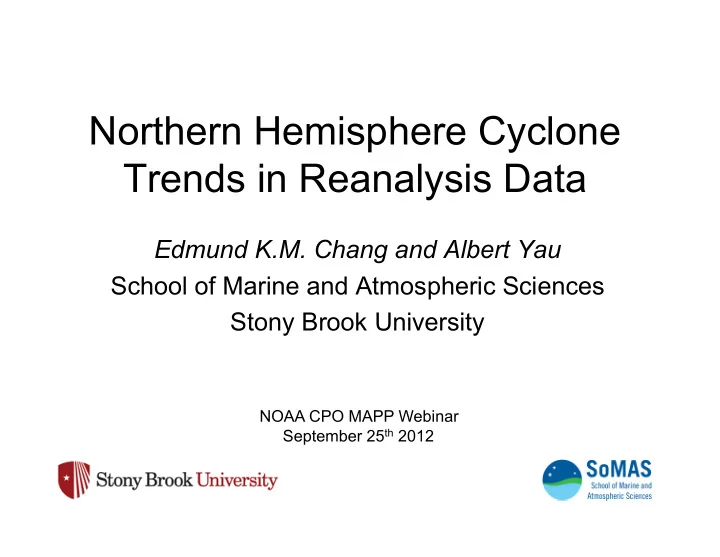

Northern Hemisphere Cyclone Trends in Reanalysis Data Edmund K.M. Chang and Albert Yau School of Marine and Atmospheric Sciences Stony Brook University NOAA CPO MAPP Webinar September 25 th 2012
• Research funded by NOAA Project: – Assessing the Quality of Synoptic Scale Variability Derived from the 20 th Century Reanalysis Project
Motivation • Several studies have suggested that NH storm track activity has increased between 1950 and 1999, mostly based on NCEP-NCAR reanalysis data: – Graham and Diaz (2001): Pacific cyclone activity – Geng and Sugi (2001): Atlantic variance statistics – Chang and Fu (2002): NH variance statistics • However, more recent studies have suggested that NCEP-NCAR and ERA40 may have spurious trends due to change in observing system – Harnik and Chang (2003): Compared NCEP-NCAR reanalysis to rawinsonde observations – Chang (2007): Compared NCEP-NCAR and ERA40 reanalyses to ship observations – Bengtsson et al. (2004): Spurious jumps in kinetic energy in ERA40 in the 1970s due to introduction of satellite data • NOAA’s 20 th Century reanalysis, using surface obs only, is expected to contain less of a spurious trend
• Previous webinar (2/14/2012): – Examined upper tropospheric trends in variance of 300 hPa v ’ – Compared to variance computed directly from rawinsonde observations – Results: • Over regions with rawinsonde observations, trends derived from 20Cv2 most consistent with those derived from observation, even though rawinsonde observations are not assimilated into 20Cv2 • Trend in Pacific derived from 20Cv2 much lower than those derived from NNR or ERA40
× : Observations Magenta: REAN filtered by Obs Cyan: Full REAN Ob 20 EC NC 20 EC NC
Further Analyses • How do these biases impact surface cyclone statistics? • Data: 6-hourly SLP data from 20Cv2, ERA40, and NCEP-NCAR reanalysis, DJF 1958-2001 • First, examine SLP variance statistics – Chang (2007) compared trends in SLP variance derived from NCEP-NCAR and ERA40 to ship observations • Trend in Pacific storm track activity based on ship observations ~20-60% of that found in NCEP-NCAR and ERA40 • Trend in Atlantic more consistent – more ship observations? • How about 20Cv2?
20Cv2: 7.7 ± 8.3% Pacific Trend: Not significant at 95% level ERA40: 11.3 ± 8.3% (41 years) NNR: 12.8 ± 7.9%
20Cv2: 14.4 ± 11.1% Atlantic Trend: ERA40: 12.4 ± 11.3% (41 years) NNR: 15.2 ± 11.9%
Difference between 1989/90-98/99 and 1959/60-68/69 SLP variance (hPa 2 ) Contours: 95% significance
• Pacific trend in SLP variance in 20Cv2 ~60% of that in NCEP-NCAR – More consistent with trend estimated based on ship observations (Chang 2007) • Atlantic trend more consistent between the 3 reanalysis datasets
Cyclone Track Statistics • Methodology – Feature tracking algorithm developed by Hodges (1994, 1995, 1999) – Tracked: • Total SLP • Filtered SLP – filtered to keep spatial scales of T5- T70 • Keep only cyclones lasting over 2 days and traveling over 1000 km
Cyclone Count as a Function of Minimum Pressure Pacific DJF 1979-2001
Pacific # of cyclones deeper than 975 hPa Pacific Trend: 20Cv2: 4.3 ± 4.9 Not significant at 95% level 1957/58-2001/02 ERA40: 3.9 ± 4.6 NNR: 5.8 ± 4.6
Atlantic # of cyclones deeper than 975 hPa Atlantic Trend: 20Cv2: 3.9 ± 5.3 1957/58-2001/02 ERA40: 4.9 ± 5.0 Not significant at 95% level NNR: 3.5 ± 4.9
Discussions Inconsistencies Between the Different Trends? Percentage trend over 41 years (1957/58 – 1998/99) # Pacific Pacific Pacific # Atlantic Atlantic Atlantic deep low* pp vv300 deep low pp vv300 20Cv2 17% 7.7% 2.6% 15% 14.4% 13.4% ERA40 16% 11.3% 13.0% 18% 12.4% 20.9% NNR 24% 12.8% 29.4% 12% 15.2% 30.0% *: < 975hPa Not significant at 95% level
Difference between 1989/90-98/99 and 1959/60-68/69 SLP variance (hPa 2 ) 300 hPa v’ variance (m 2 s -2 ) Contours: 95% significance
Difference between 1989/90-98/99 and 1959/60-68/69 SLP mean (hPa) 300 hPa Z mean (m) Contours: 95% significance
Discussions • Significant mean flow change over Atlantic – Consistent with significant storm track change • Very little mean flow change over Pacific – Inconsistent with large storm track change • Large change in number of deep cyclones ( < 975 hPa) over Pacific – Perhaps in part due to trend in SLP? • Mean SLP decreased by ~3 hPa between 1960’s and 1990’s near the Aleutians
- Cyclones defined by removing seasonal mean and large spatial scale (retained scale: T5-T70) - # deep cyclones ( < -25 hPa) in Pacific Pacific Trend (1957/58-2001/02): 20Cv2: -0.9 ± 4.4 ERA40: +3.0 ± 4.2 NNR: +3.3 ± 4.1 Not significant at 95% level
Conclusions • Trends in NH winter storm track activity from 1957/58 to 1998/99 have been compared between 20C, NNR, and ERA40 reanalyses – In terms of 300 hPa v’ variance, SLP variance, and surface cyclone statistics • Atlantic trend largely consistent, except NNR trend in 300 hPa v ’ variance is much larger and is likely biased high – Also consistent with significant trend in mean flow over Atlantic • For Pacific, 20C reanalysis does not show a significant trend in any of the storm track quantities examined – Over regions with observations, trends derived from 20C reanalysis most consistent with those derived directly from observations (rawinsonde and ship) – Very little trend in mean flow over Pacific, inconsistent with significant trend in storm track activity in NNR and ERA40 • Upper level trend more biased in NNR and ERA40 likely because of increasing number of aircraft and satellite observations from late 1960s through late 1970s
Recommend
More recommend